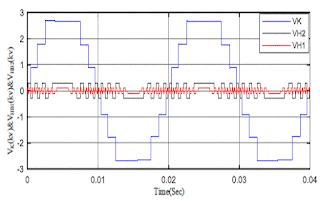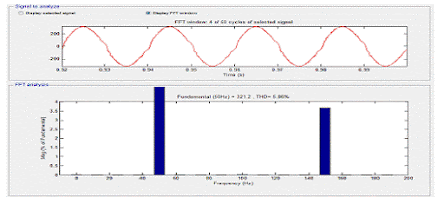ABSTRACT:
The
high-frequency magnetic link is gaining popularity due to its light weight,
small volume, and inherent voltage balancing capability. Those features can
simplify the utilization of multilevel converter (MLC) for the integration of
renewable energy sources to the grid with compact size and exert economic
feasibility. The modulation and control of MLC are crucial issues especially
for grid connected applications. To support the grid, the converter may need to
operate in over-modulation (OVM) region for short periods depending upon the
loading conditions. This OVM operation of the converter causes increased
harmonic losses and adverse effects on overall system efficiency. On top of
that, the size and cost of filtering circuitry become critical to eliminate the
unwanted harmonics. In this regard, a modified OVM scheme with phase disposed
carriers for grid connected high frequency magnetic link-based cascaded
H-bridge (CHB) MLC is proposed for the suppression of harmonics and the
reduction of converter loss. Furthermore, with the proposed OVM technique, the
voltage gain with modulation index can be increased up to the range which is
unlikely to be achieved using the classical ones. Extensive simulations are
carried out with a 2.24 MVA permanent magnet synchronous generator-based wind
energy conversion system which is connected to the 11 kV ac grid through a
high-frequency magnetic link and a 5-level CHB MLC. A scaled down laboratory
prototype is implemented to validate the performance of the converter.
KEYWORDS:
1. Multilevel converter
2. Over modulation
3. Grid connection
4. High-frequency magnetic link
5. Wind energy
SOFTWARE: MATLAB/SIMULINK
BLOCK DIAGRAM:
Fig.
1. Control scheme for high-frequency magnetic link coupled, five-level cascaded
H-bride converter-based grid-connected wind energy conversion system.
EXPECTED SIMULATION
RESULTS:
Fig.2.
Fundamental voltage (normalized) in OVM region: (a) regular and (b) proposed
methods.

Fig.
3. Simulated performance of the system: (a) dq current components, (b)
rated output power, (c) line voltage, (d) dc-link voltage, and (e) converter
side line voltage.
Fig.
4. Carrier signal modification to go from linear modulation to OVM mode
(frequency is deliberately reduced to have better view).
Fig.
5. Simulated performance of the system after load inclusion for sinusoidal PWM:
(a) dq current components, (b) output reference signals from the
controller, (c) line voltage (after filter), (d) line current (after filter),
and (e) dc-link voltage.
Fig.
6. Converter output voltage profiles with momentary OVM region for different
modulation schemes: (a) SPWM, (b) THSDBCPWM, (c) SSDBCPWM, and (d) THPWM.
Fig.
7. (a) High-frequency gate pulses to drive high frequency inverter and (b) gate
pulse generation from DSP F28335 for single phase voltage generation of
five-level CHB converter (proposed OVM with third harmonic injected signal).
Fig.
8. (a) High-frequency magnetic link primary and secondary voltage with
rectified output voltage and (b) primary and secondary voltage with corresponding
magnetizing current.
Fig.
9. (a) B-H loop of the core with high-frequency excitation with 1.2 μs
dead-band and (b) core loss with 10 kHz square wave excitation.
Fig.
10. Converter overall performance under existing (left column) and proposed
(right column) OVM technique with third harmonic injected signal.
CONCLUSION:
To
improve the system performance, a modified OVM technique is presented in this
paper with grid connected and islanded operation. With the proposed modified
carrier signal based BCPWM techniques, the overall loss and THD are decreased
for both the islanded and grid connected modes compared with the traditional
OVM techniques. Moreover, the voltage gain can be increased and remains
approximately constant in the proposed method, which may not be possible to
obtain using the traditional OVM methods. In this paper, a high-frequency
magnetic link-based fully-rated CHB converter is developed for wind energy
applications and the behavior of the system under rated and overrated load conditions
are investigated.The use of magnetic link for the generation of isolated and
balanced dc sources of the MLC inherently overcomes the voltage imbalance
problem of CHB MLC and hence effectively simplifies the system control
complexities. The core loss of high-frequency magnetic link is also measured to
identify the overall loss of the system. The effectiveness of the proposed
technology is confirmed by the simulation and experimental results.
REFERENCES:
[1]
M. R. Islam, Y. G. Guo, J. G. Zhu, H. Lu, and J. X. Jin, “High-frequency
magnetic-link medium-voltage converter for superconducting generator-based
high-power density wind generation systems,” IEEE Trans. Appl. Supercond.,
vol. 24, no. 5, pp. 1–5, Oct. 2014.
[2]
N. Mendis, K. M. Muttaqi, S. Perera, and S. Kamalasadan, “An effective power
management strategy for a wind–diesel–hydrogen-based remote area power Supply
System to meet fluctuating demands under generation uncertainty,” IEEE
Trans. Ind. Appl., vol. 51, no. 2, pp. 1228–1238, Mar.–Apr. 2015.
[3]
B. Jain, S. Jain, and R. K. Nema, “Control strategies of grid interfaced wind
energy conversion system: An overview,” Renew. Sustain. Energy Rev.,
vol. 47, pp. 983–996, Apr. 2015.
[4]
Y. Tan, K. M. Muttaqi, P. Ciufo, and L. Meegahapola, “Enhanced frequency
response strategy for a PMSG-based wind energy conversion system using
ultracapacitor in remote area power supply systems,” IEEE Trans. Ind. Appl.,
vol. 53, no. 1, pp. 549–558, Jan.–Feb. 2017.
[5] M. R. Islam,
Y. G. Guo, and J. G. Zhu, “A multilevel medium-voltage inverter for
step-up-transformer-less grid connection of photovoltaic power plants,” IEEE
J. Photovolt., vol. 4, no. 3, pp. 881‒889, May 2014.











































